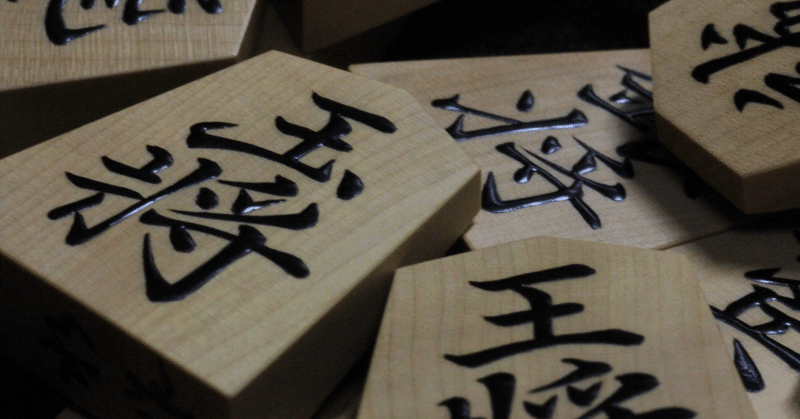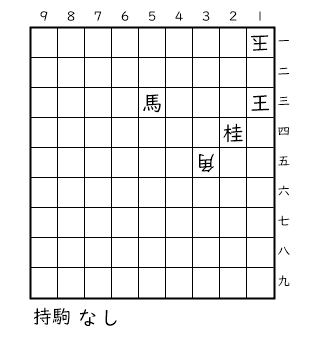
Basic Rules of Tsume Shogi
I attempted to write the basic rules of tsume shogi in English. If you have any concerns or questions, please feel free to comment.
What is Tsume shogi ?
Tsume shogi (詰将棋) is a form of puzzle using shogi pieces on a shogi board where the objective is to checkmate the opponent's king.
Tsume shogi has two aspects: it serves as an exercise for the endgame in shogi and as a work of art. Many shogi players solve tsume shogi problems to learn tactics for checkmating the king and to improve their ability to plan out a long series of moves before achieving a goal.
On the other hand, some tsume problems feature brilliant moves or unbelievable concepts that don't seem to appear in actual shogi games. Vivid sacrifices, contrasting elements, and concise expressions that convey a specific theme, among others, are ways in which composers express their ideas on the shogi board. Tsume shogi achieves beauty by transcending the context of shogi.
Sente and Gote
A tsume shogi problem is posed in the form of a shogi diagram. The Attacker (攻方 $${\textit{Semekata}}$$), also called $${\textit{Sente}}$$ (先手), plays first from the bottom. The Defender (受方 $${\textit{Ukekata}}$$), also called $${\textit{Gote}}$$ (後手), plays from the top.
Pieces

In a diagram, shogi pieces are indicated in kanji. Gote’s pieces are displayed upside down. In this book, Sente’s pieces in hand (持駒) are shown below a board. Gote’s pieces in hand are not shown, but Gote has all the rest in hand. For example, in the diagram below Gote has 飛2 角2 金2 銀4 桂3 香4 歩17 in hand.

As a side note, Sente’s king may be used in tsume shogi problems. The character 王 is customarily used instead of 玉 to represent Sente's king.
If Sente has no pieces in hand, なし (none, $${\textit{nashi}}$$) is indicated in the diagram.

Movement
Pieces may move as shown in the diagram below:
・Unpromoted Piece

・Promoted Piece

Notation
The rows and columns of the board are numbered 1 to 9 as shown below in this book, therefore each square on the board can be uniquely identified.

Moves are written as follows by combining the above numbers with the abbreviations for pieces, information on promotion, etc.:
P-14:The pawn moves to 14.
R*21:The rook is dropped on 21.
+Bx34:The horse captures a piece on 34.
N-33=:The Knight moves to 33 and does not promote.
L-13+:The Lamce moves to 13 and promotes.
G-37(48):The gold at 48 moves to 37.
If multiple pieces of the same type can move to the square, they are identified by notating which square a piece is moving from.
Illegal Moves
Both Sente and Gote must avoid making illegal moves. The illegal moves in tsume shogi include:
Double Pawns: You cannot drop a pawn onto a file that already contains one of your pawns (promoted pawns excluded).
Drop Pawn Mate: You cannot give a checkmate by dropping a pawn.
Piece with No Moves: You cannot drop or move a piece to a square where it cannot move at all (such as dropping a knight to an opponent's last two ranks, etc.).
Basic Rules of Tsume Shogi
Solvers must be aware of the following rules:
Sente must achieve checkmate through a continuous series of checks.
Gote has in hand all pieces not on the board or in Sente's hand, except for Sente's king.
Gote can interpose a piece to block a check by a line piece (rook, bishop, lance, dragon, or horse). However, interposing pieces that are immediately captured without bringing any benefit to Gote or fundamentally changing the subsequent series of moves are termed "futile interpositions" (無駄合), and Gote may not resort to them. When Gote's king is in check, and Gote has no choice but to resort to futile interposition, Gote is not strictly in checkmate, but it is considered checkmate in tsume shogi.
Gote must play the best move on every turn, following the rules below:
If there is a move to prevent checkmate regardless of the moves Sente plays subsequently, Gote makes that move.
When all moves Gote can play ultimately lead to checkmate, Gote makes a move to delay checkmate for as long as possible.
In 2, when multiple moves lead to the longest series of moves to checkmate, Gote selects a move that results in a mate position where Sente has no pieces in hand. If there are multiple such moves, Gote is free to choose any move from among them.
The longest sequence of moves, as determined by the above rules, is referred to as the main line (作意, $${\textit{sakui}}$$) and serves as the solution to a tsume shogi problem. A sequence that is not the longest or, if it is the longest, results in a checkmate position where Sente has some pieces in hand is called a variation (変化, $${\textit{henka}}$$).
In a variation, Sente must mate in the smallest number of moves, using as few as possible of his pieces in hand. In the main line, Sente may make any move if it leads to checkmate.
Futile Interpositions
The diagram 1 is a one-move checkmate problem with R-14 (see diagram 2).

In an actual shogi game, Gote is free to drop a piece, for example, P*13, if Gote would like. However, even if Gote drop a pawn on 13, being taken by the rook is the only outcome, and the situation remains unchanged. This is a futile interposition. In tsume shogi, futile interpositions are not allowed. The king in Diagram 2 is already considered checkmated.
Let's look at another example. Diagram 3 is also a one-move checkmate. The solution is B*31 (see diagram 4). Dropping a piece, for instance, P*22, for Gote in Diagram 4 is a futile interposition. The reason is that Sente delivers an immediate checkmate with +Rx22.

Main Line and Variation
Diagram 5 is a three-move checkmate problem, and the solution is 1.+Rx13, 2.Nx13, 3.G*22 (Diagram 6). Using this tsume shogi as an example, I will explain the main line ($${\textit{sakui}}$$) and variations ($${\textit{henka}}$$).

When illustrating the branches of each position, it looks as follows:

Against 1.+Rx13, Gote has two options: 2.Nx13 or dropping a piece on 12, such as 2.P*12. After 2.Nx13, Sente plays 3.G*22 and Gote’s king is in checkmate. If Gote plays 2.P*12, Sente can mate Gote's king with either 3.+P-22 or 3.G*22. However, according to Rule 6 explained in “Basic Rules of Tsume Shogi,” Sente needs to checkmate in a way that results in having surplus pieces in hand if possible. Therefore, 3.+P-22 is the correct move. In summary, (1) 1.+Rx13, 2.Nx13, 3.G*22 is the main line, and (2) 1.+Rx13, 2.P*12, 3.+P-22 is a variation.
Hendou
According to Rule 4-3 as described in the “Basic Rules of Tsume Shogi,” there may be multiple sequences of moves that are the maximum number of moves to checkmate. Those sequences are called hendou (変同, 変化同手数駒余らず). The solver is free to provide any of those sequences as the solution. Let me explain with an example.
Diagram 7 is a three-move checkmate problem. The correct first move is 1.N* 23 (Diagram 8).

In response to that move, Gote has several options, but in each case, Sente can drop a gold to achieve checkmate as follows:

No matter what move Gote makes as the second move, the number of moves to checkmate is three and Sente has no pieces in hand in the mate position. Therefore, any of (1) to (3) is correct. However, due to space constraints, it is common to include only one of (1) to (3) on the printed material.
Cook
There are some restrictions on the composer as to what constitutes a valid problem. In the main line, in every position for Sente, there must fundamentally be only one move leading to checkmate. If there are multiple moves leading to checkmate in a position for Sente, unintended moves by the composer are referred to as cooks (余詰 $${\textit{yozume}}$$), and a tsume shogi with a cook is considered invalid. However, in variations, it is perfectly fine to have multiple moves in positions for Sente leading to checkmate.
Cooks occurring in the final move of the main line is exceptionably allowed. However, in the case of a one-move checkmate problem, no cooks are allowed.
Dual
Strictly speaking, while it is a cook, if the difference between moves is sufficiently small, it is called a dual (非限定) and is considered acceptable. I will introduce two examples of duals.
Diagram 9 is a three-move checkmate problem with the solution being 1.Sx12+, 2.Kx12, 3.R*13. However, even the move 1.Sx12= can checkmate Gote's king. When subsequent moves remain unchanged regardless of promotion, it is considered a dual, and there is no issue with the problem as a composition.

Diagram 10 is a three-move checkmate problem with the solution being 1.B*33, 2.K-21, 3.B-22+. However, Sente can drop a bishop anywhere from 33 to 99 on the first move and checkmate the king. When subsequent moves remain unchanged, regardless of where Sente drops a line piece on its line, it is considered a dual and is valid as a composition.
この記事が気に入ったらサポートをしてみませんか?
